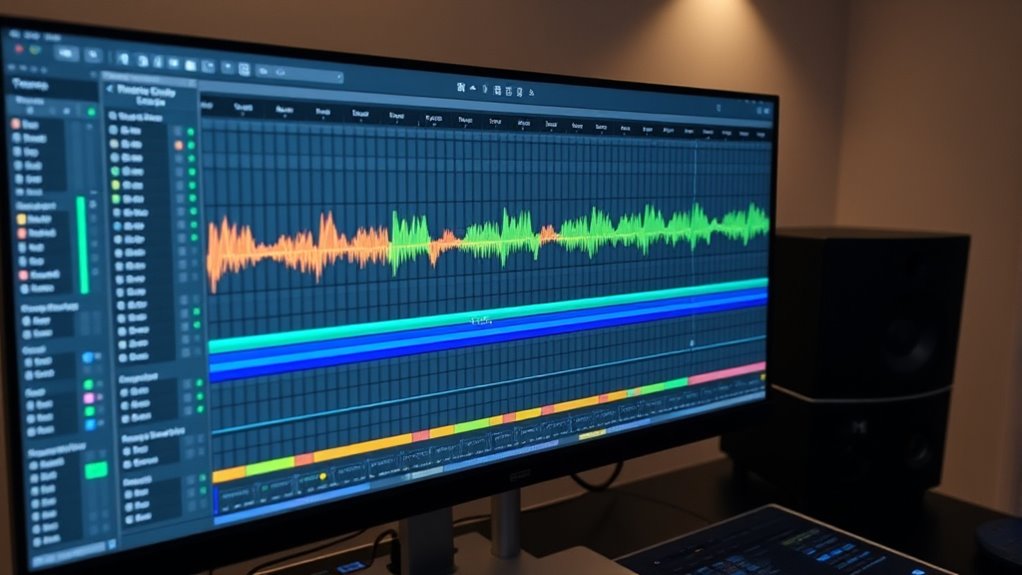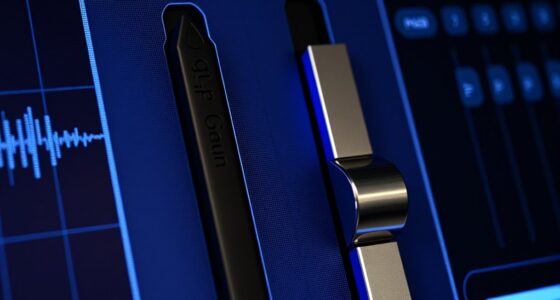To achieve a clean mix, you should organize your session with track groups, folders, and busses. Group similar tracks like vocals and drums to streamline control and processing. Use folders to keep your session tidy and make elements easy to locate. Route related tracks to busses for cohesive effects and better overall balance. Combining these techniques helps you maintain clarity and efficiency, and you’ll discover more ways to optimize your workflow as you continue exploring.
Key Takeaways
- Use track groups to organize similar elements, simplifying control and reducing session clutter.
- Route related tracks to dedicated busses for cohesive processing and easier balancing.
- Employ folders to visually organize tracks and enable quick access or muting of entire sections.
- Combine grouping, routing, and folders for a layered, logical workflow that maintains session clarity.
- Proper organization enhances control, efficiency, and results in a cleaner, more professional mix.

Organizing your tracks effectively is key to achieving a clean, professional mix, and using track groups, folders, and busses can make this process much easier. When you employ grouping techniques, you streamline your workflow by consolidating similar tracks, such as vocals, guitars, or drums, into single entities. This allows you to apply processing, like EQ or compression, uniformly across multiple tracks without having to tweak each one individually. Grouping also helps you visualize your session more clearly, reducing clutter and making it easier to focus on specific elements during mixing. Incorporating organized session structure can further enhance your efficiency and clarity. Bus routing strategies are essential to maximize the benefits of track grouping. By routing related tracks to dedicated busses, you create a flexible system for processing and balancing your mix. For example, routing all drum tracks to a drum bus enables you to control the entire drum kit with a single fader and apply cohesive processing like parallel compression or reverb. This approach not only saves time but also preserves the overall coherence of your sound. You can also set up subgroup busses within your session for different instrument sections, allowing for more detailed control over dynamics and effects. Folders are another organizational tool that enhances your workflow. By placing related tracks into folders, you keep your session tidy, making it easier to locate and manage individual elements. For instance, grouping all percussion tracks into one folder lets you quickly solo or mute that section without scrolling through the entire session. Folders also serve as visual cues, helping you maintain a clear overview of your project structure. When combined with track groups and bus routing, folders become a powerful way to keep your mix organized, especially as your session grows in complexity. Using these techniques together, you can establish a logical, efficient routing system. Start by grouping similar tracks with appropriate grouping techniques, then route these groups to dedicated busses for processing. Wrap this up by organizing your tracks into folders for quick access and visual clarity. This layered approach ensures your mix remains clean and manageable, giving you more control over the sound and making the mixing process smoother. With practice, you’ll find that these organizational strategies not only save time but also improve the overall quality of your mixes, allowing you to focus more on creativity and less on session chaos.
Frequently Asked Questions
How Do I Decide When to Use Track Groups Versus Folders?
You should use track groups when you want to control multiple related tracks with subtle automation or apply effects collectively, like vocals or drums. Folders are best for organizing your project, keeping it tidy and easy to navigate. If you’re focusing on creative grouping for mix balance or processing, track groups give you more flexibility. Use folders for structure, and track groups when you need precise control and automation.
Can Busses Be Used for Effects Processing?
Imagine a dedicated hallway where your audio signals gather before reaching the main stage—that’s your processing bus. Yes, busses can definitely be used for effects processing, acting as a central hub for applying effects like reverb or delay to multiple tracks. This setup streamlines your workflow, allowing you to control and tweak bus effects easily, giving your mix a cohesive, polished sound without cluttering individual tracks.
What’s the Best Way to Organize Large Session Sessions?
To organize large sessions effectively, you should implement a clear folder hierarchy and subgroup management. Create main folders for major sections like drums, vocals, and guitars, then subfolders for individual tracks. Use track groups to combine related tracks for easy processing and organization. This approach keeps your session tidy, speeds up workflow, and guarantees you can quickly locate and manipulate specific elements during mixing.
How Do I Prevent Phase Issues With Bus Routing?
Imagine you’re in a medieval castle, trying to keep the peace—same with your tracks and buses. To prevent phase issues, always check for phase cancellation when routing signals through buses. Keep your stereo imaging intact by maintaining consistent panning and avoiding summing tracks with out-of-phase signals. Use phase meters and flip the phase when needed. This keeps your mix clear, focused, and free from unwanted comb-filter effects.
Are There Specific Naming Conventions Recommended for Clarity?
Yes, using consistent naming conventions greatly improves clarity in labels. You should adopt clear, descriptive names for your track groups, folders, and busses, like “Vocals_Main” or “Guitars_Rhythm,” to avoid confusion. Stick to a uniform style, such as lowercase or camelCase, and include relevant details like instrument type or purpose. This consistency helps you quickly identify and manage your mix, ensuring a more organized and efficient workflow.
Conclusion
By mastering track groups, folders, and busses, you streamline your workflow, organize your sessions, and achieve cleaner mixes. Group your tracks for quick adjustments, folder them for easy navigation, and send them to busses for cohesive effects. Simplify your process, enhance your control, and elevate your mixes. When you implement these techniques consistently, you save time, reduce clutter, and create polished sounds—making your music production more efficient, more focused, and more professional.










